Published 20 August 2017 ● Last Updated on 30 September 2020
When I started setting up my new house a few months back, I asked myself where should I start to go green?!! And then it dawned on me – the Kitchen. Let’s face it, it’s the busiest and most important part of a household. It’s where we all connect, through food, through chores, through new experiments (both the yucky & yummy ones). It is where we find solace in a cup of hot cocoa, where we find our comfy munchies and guess what, it is where we can start to go green.
Wondering where I am coming from ?!! Let me elaborate further.
Where do all your big appliances sit? Where do you generate most of the household waste? What’s the second highest consumer of water in your house? Which place needs frequent cleaning and maintenance? That’s right… the Kitchen.
If you are renting out an apartment, then you might not be able to make too many structural changes to the existing design. However, there is a fair bit you can opt to do before you move in and on an ongoing basis after. Of course, if you are setting up your own apartment, then it’s an entirely different story. You can go for as many green designs and changes as you like to make it eco-friendly to the core. In my home, I was lucky enough to get a kitchen with ample light and ventilation. So the power consumption was well under control.
Stage 1: Structural Design
1. Think timeless
Always focus on creating something durable because that is key to sustainable construction. Plan carefully before breaking ground to prevent further need for renovations. It doesn’t matter how eco-friendly something is if it has to be replaced over a few years. It will eventually make its way to the landfill. Keeping to the theme of the furnishing ‘classic’ will save you getting stuck with things that need to be replaced for the sake of aesthetics!
2. Natural lighting and ventilation
Well-placed windows, skylights and attached utility areas in your kitchen can minimize the need for artificial lighting or ventilation. A handy tip: South-facing skylights have a high potential for passive heating and ventilation. Add movable coverings or a special glaze on such windows though, so they can help block the excessive summer heat. Another way to add more natural light is to create an open floor plan and connect utility areas/balconies through the kitchen. This will allow reflected light and avoid the extra heat caused due to direct sunlight in the kitchen.
Here are some gorgeous ideas for illuminating your kitchen from houzz.co.uk
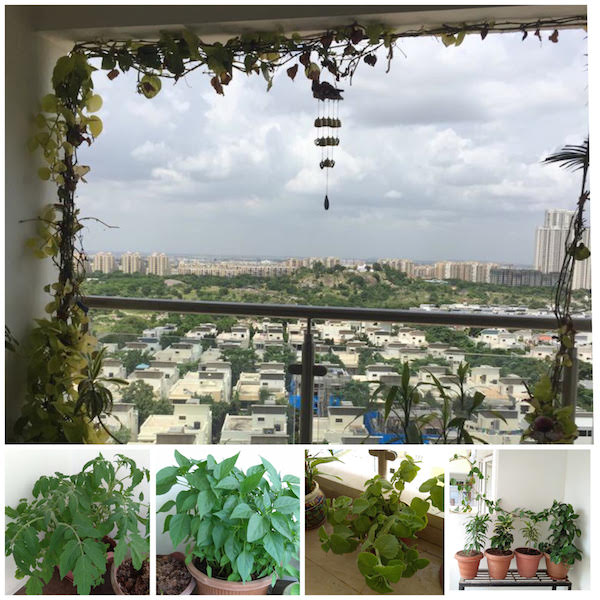
Facts: Use of LED bulbs and CFLs (compact fluorescent lamps) can reduce energy consumption by 50% to 70% as compared to incandescent bulbs. According to energystar.gov, in USA, a single compact fluorescent bulb with a lifespan of 10,000 hours, saves $30-$40 over incandescent lighting of similar luminosity.
My suggestion would be to optimize the amount of light needed in the kitchen. So instead of a single high luminosity bulb, consider the appropriate quality of light focused on task areas e.g. counter top, sink and cutting area. Install occupancy sensors, dimmers, timers etc. That way, you can minimize electricity usage in the evening hours.
In Singapore: LED bulbs and candles are available at various shops, including IKEA. For regular household use, you can easily find Philips LED bulbs in your nearest NTUC Fair Price or Cold Storage outlets.
4. Sustainable kitchen cabinets
Make sure your kitchen cabinets are made from wood/engineered wood certified by the Forest Stewardship Council (FSC) which means they are manufactured using sustainable forest management practices. These cabinets use formaldehyde-free glues and low volatile organic compounds as veneer to prevent toxic fumes. You can also look for cabinets made of wheat board and straw board. They’re made from agricultural waste and are rated to exceed the standards set by the American National Standards Institute for medium density particleboard. Then there is FSC Certified renewable bamboo wood – stronger and harder than most hardwoods, bamboo extends a certain amount of grace to the overall look of your kitchen too!
In Singapore: Want scented interiors? Look at the Orangoid range from Panelogue which is made from recycled raw materials such as peppermint stalks, vanilla husk and coffee beans! If you prefer the standard chic look go for EDL’s made in Italy range of laminates crafted from paper based and sustainably sourced materials.
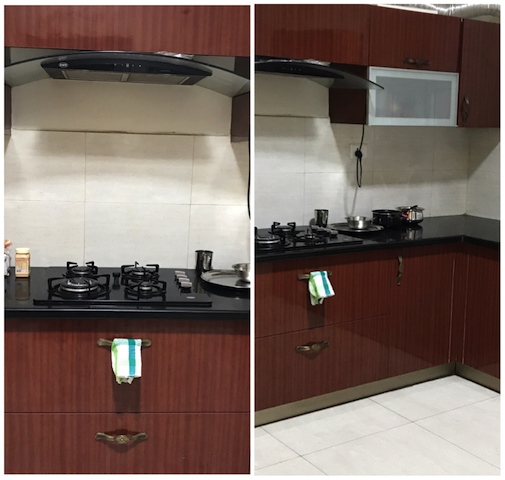
5. Green counter-tops
Eco-friendly counter-tops consist of recycled, sustainable components, adhesives with low toxicity quotient, and green manufacturing process. Examples and pointers to such manufacturers:
- Squak Mountain Stone: Components are recycled glass, recycled paper, fly ash etc. These resemble limestone and soapstone.
- Eco-top: Consists of recycled paper, renewable bamboo fiber and water-based resin glue.
- Vetrazzo: These are 85% recycled glass—almost all the glass comes from curbside recycling programs.
- Craft-Art: Wood countertops made of reclaimed wood from older barns, warehouses, and commercial buildings.
In Singapore: Check out the Silestone Euro countertop material from Cosentino which is made from 75% recycled materials like as porcelain, glass, ash, and waste generated by blast furnaces. The best part- almost all the water used in this manufacturing process is reused!
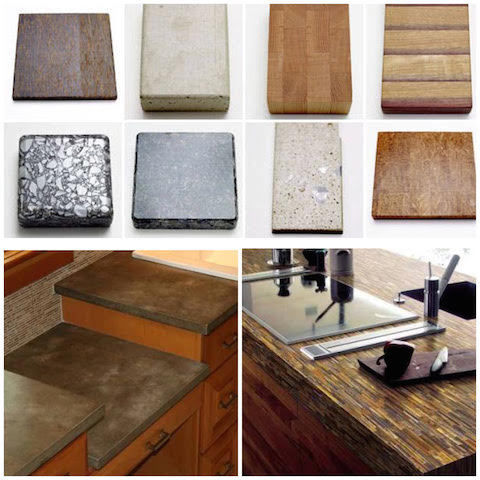
Kitchen floors get lots of wear and tear, so durability is of primary importance. Here too, you can try out sturdy and sustainable ways. Options to consider:
- Linoleum -Made from renewable and natural components like linseed oil, tree resin, wood and cork flours, limestone, and pigments, linoleum is purportedly non-allergenic in nature.
- Tiles made from recycled materials
- Salvaged or reclaimed wood
In Singapore: For environment-friendly floor solutions, you can look at the Brick range from Ragno Tiles at Rice . If you prefer wooden floors check out WOW floors or Mafi . Rice, WOW floors and Mafi are Singapore-based stores.
7. Buy local
It’s a good idea to check out raw materials that are abundant locally. Reclaiming or salvaging existing materials is the most eco-friendly and economical option. Apart from that, sourcing some materials tend to be more eco-friendly than others. I came across a Life Cycle Assessment software which helps consumers assess the sustainability index of building materials. This tracks processing details, sourcing, recyclability etc. This will help you find the most sustainable source of any material you want to use in kitchen interiors.
In Singapore: It is heartening to see the maker movement gaining momentum in Singapore. Have an electrical appliance that doesn’t work anymore? Old or new, don’t bin it. Wait for the last Sunday of the month and head over to the monthly Repair Kopitiam–fix-it-yourself workshops– organized by Sustainable Living Lab in Jurong and Tampanies.
Stage 2: Appliances
Appliances are the major investments we make while setting up a house. What if I say we can opt for eco-friendly ones and save a lot of money while we are at it? I decided to go for a low power consuming refrigerator, microwave oven and dishwasher. Apart from these, I made sure to get smaller appliances with better energy ratings. So make sure that you prioritize long-term benefits over other features while shopping for major appliances. The initial high cost is aptly offset by the lower utility bill and longer lifespan of these appliances. While appliance shopping, look for the Energy Star® rating to find the most efficient models. (Smaller models tend to be most efficient.)
In Singapore: Download the myENV mobile on your andriod or iPhone by the National Environment Agency [NEA Singapore] app to calculate the Lifecycle Cost [LCC] for various electrical appliances. Alternatively, just click here to calculate the LCC now. If you have come this far in the article, you are clearly interested- always choose a model with lower LCC. Want to check the energy efficiency of the model you are looking at? Just click here
As of 2012, the weighted energy consumption profile across all housing types in Singapore shows that air-conditioners, water heaters and refrigerators account for about 75% of the total electricity consumption! Use the myENV app if you wish to conduct a Home Energy Audit for your home.
8. Dishwasher
A dishwater with Energy-Star ratings can be more efficient in terms of power and water consumption. There are a few points to note – Firstly, I run the dishwasher only when it’s at least 80-90% full. Secondly, I keep pre-rinsing minimal as modern dishwashers get rid of grease and food residue efficiently. Moving forward, search for dishwashers that include an air-dry option, i.e drying through circulation fans rather than heating elements. This will cut down power consumption significantly. Importantly, replace dishwashers that are older than 10 years. You will end up saving a lot on electricity as the Energy Star-rated dishwashers are 10% more energy efficient and 20% more water efficient than standard models.
In Singapore: The Bosch range of dishwashers come with energy and water saving features. Each full run uses 8-10 litres of water- a good average by industry standards. There is also a half load option available for those times when you do not have enough dishes to wash
9. Sensor faucets or foot pedal
Though using a dishwasher is water efficient, it’s only applicable if you’re washing a full load of dishes. On some days if you have very few dishes to clean, better to go for hand washing. Of course, there will be water wastage as your hands will be full to close the tap every time you scrub a pan!! Sensor faucets & foot pedals can come to your rescue here. These are quite handy as they can control water flow through a tap of your foot or wrist and sometimes even without touching the sink handle (Motion Activated Sensors). This is perfect for the cleanliness freaks out there and of course for a household with kids.
In Singapore: Kohler has a wide range of sensor faucets at various locations.
Studies say that new models of refrigerators are 75% more energy efficient, saving about $100 per year on energy costs. An Energy Star-rated model will save an additional $20-$30 per year. While choosing a refrigerator, go for models featuring separate freezer compartments on top and use 10% to 25% less energy than a same-sized model with a side-by-side configuration.
Usage Tips:
- Check user’s manual to know the optimal temperature range & set it accordingly.
- Reserve cold zones for foods that get spoiled easily.
- Use glass or ceramic containers. These are long-lasting than plastic or foil and also provide better insulation barrier.
In Singapore: There is a wide range of energy efficient models (you’ll be left confused trust me!) available today. Download the myENV mobile on your android or iPhone by the National Environment Agency [NEA Singapore] app to calculate the Lifecycle Cost [LCC] for various electrical appliances. Alternatively, just click here to calculate the LCC now. If you have come this far in the article, make a note to always choose a model with lower LCC. Want to check the energy efficiency of the model you are looking at? Just click here
11. Water purifier
Clean water is of paramount importance for your health-so never compromise on that. Unfortunately, the conventional Reverse Osmosis Purifiers waste a lot of water. There are two ways to counter this:
- Reuse the waste water from the purifier to water your herb garden
- Reduce Reverse Osmosis usage by using over the counter purifiers. I found really interesting options on the Eartheasy website .
In Singapore: There is a wide range of over the counter water purifiers in Singapore available at Courts. Have a look and see what works best for your home.
12. Other Appliances
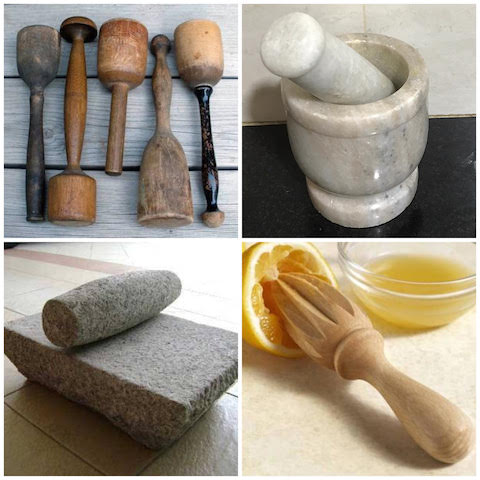
Three things need to be kept in mind here.
- Go for Energy star rated, smaller appliances, keep in mind your family size while making the purchase
- Reduce usage of fossil fuel by energy efficient electrical appliances– Use induction cooktops, electric kettles, rice cooker, toaster whenever possible to take away the load from the cooking gas.
- Choose mechanical options over electrical ones– For smaller day-to-day needs, try using stone mortar pestle instead of mixer-grinders, handheld whiskers instead of electric blenders and so on. Trust me… It takes less time to clean afterwards!!
There you are… Go ahead & design the perfect kitchen for your family and explore so many options to go green in the process.
Image credits: Ladies from Mahindra Ashvita, Hyderabad and Padmalaya Mallick
-Padmalaya
Padmalaya Mallick is a Business Consultant at Deloitte on weekdays. She is an avid bibliophile, a rather moody writer and painter during weekends but– more importantly a traveler and day-dreamer! Her love for nature comes from her dad, who she credits with teaching her everything she knows about urban farming & recycling. Padmalaya aspires to change people’s perception that going green is drab. In fact, she wants to show the world how amazingly elegant ‘eco-friendly lifestyle’ can become.




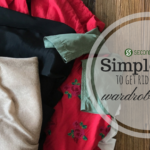
0 Comments